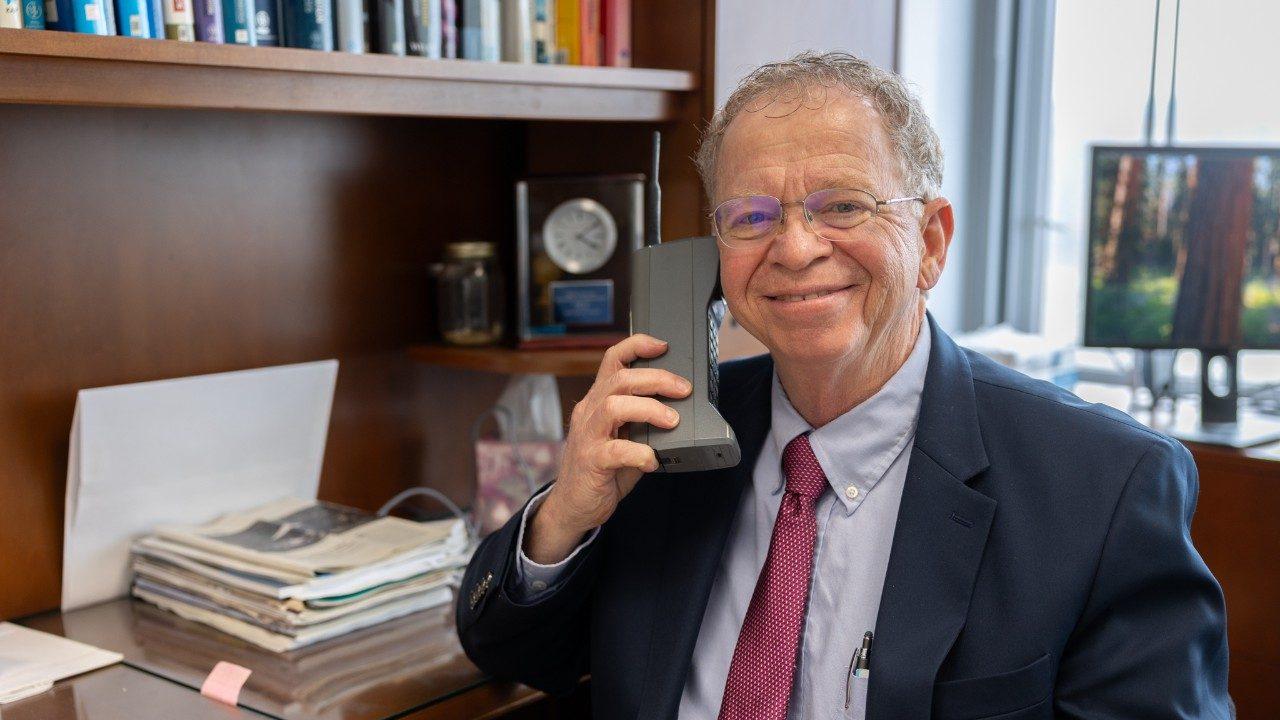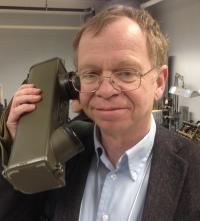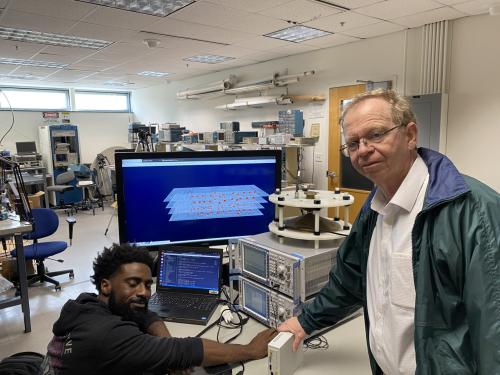
Meet the Three-Time Aggie Engineer Named to the National Academy of Inventors
Alum Jeff Reed embodies Aggie Engineer Spirit and core value of College of Engineering
There’s a foundational truth constituting Aggie Engineers: They strive to create a better tomorrow by solving the world’s most pressing challenges.
Jeff Reed, a three-time electrical and computer engineering alum of the University of California, Davis, knows this. In fact, he embodies it. When he was a doctoral student in the ‘80s, there were few challenges bigger, more exciting and promising than wireless communications.

“Today, it would be like being a faculty member who helped develop ChatGPT,” he said, describing the air around wireless communications research at the time.
Now, nearly four decades later, he’s an internationally recognized leader in wireless communications and a recently elected fellow of the National Academy of Inventors for his patented technological breakthroughs in the field.
Throughout his career, Reed’s scientific collaborations and leadership have significantly shaped the planet and its future — and communicate the innovative spirit of Aggie Engineers.
Lifelong Curiosity
Growing up in Bakersfield, California, Reed’s natural curiosity in technology developed within the stretching, fertile geography of the Central Valley.
“I was always wanting to build things, make things,” he said. “I was an inquisitive kid.”
Throughout his childhood, he made electronic devices from scratch. This culminated in a high school project where he made a tool capable of measuring and displaying the heart's electrical activity — essentially, a fully functional EKG.
Reed found a home where he could nurture this interest when he transferred to UC Davis from Bakersfield College in 1977. In quick succession, he received his bachelor’s degree and his master’s degree in electrical and computer engineering.
Signal Boost
With his master’s and a few years of industry experience in Silicon Valley in tow, Reed came back to UC Davis. He decided to pursue his Ph.D. in electrical and computer engineering under Professor Emeritus Tien C. “Steve” Hsia, focusing on adaptive signal processing, interference rejection and communication systems.

In 1983, around the same time Reed was starting his graduate studies, AT&T launched the first American cellular network, which served Chicago, Illinois. Few people at the time realized how much cellular communications would impact everyday life.
“It was the right topic at the right time,” he said.
Reed says his focus on interference management positioned him for early impact in the developing field of wireless technologies. Interference management is about developing processes for minimizing noise or disruptions to cell phones, ensuring a clear and stable line of communication.
“Immediately after graduation in 1987, cellular started to become red hot. We had officially entered the era of cellular communications.”
Instead of going back to industry, Reed decided to stick around campus. He worked as a private consultant and part-time researcher and teacher for the College of Engineering.
Staying around campus meant he had the opportunity to collaborate with an at-the-time new faculty member in the Department of Electrical and Computer Engineering, Kamilo Feher. Feher would become famous for his research in wireless communications in the decades following (case in point: he has authored six professional books and 300 papers on the topic and has 14 patents related to wireless communications).
“I learned a lot about cellular communications from Feher,” Reed said. “And what I learned from him positioned me very well for a faculty position at Virginia Tech.”
Right Place, Right Time
As Reed said, wireless was red hot. When he joined Virginia Tech as an assistant professor of electrical and computer engineering in the early ‘90s, the university had recently launched the Mobile and Portable Radio Research Group.
The innovative group played a central role in the rapid advancement of wireless technologies in the United States at the end of the 20th century. One of the earliest projects Reed contributed to as part of the team was E911. This allows emergency dispatchers to locate the position of the person who has called in for help over a cellular network and quickly became a mandatory component of all phones — even the most forward-thinking smartphones of today.
He also helped work on the Global System for Mobile Communications, or GSM. This standard defined the cutting-edge of cellular networks in the ‘90s and paved the way for the generations to follow, such as the modern 5G network. Through these efforts, he met Marty Cooper, widely considered the inventor of the cell phone, and Norm Abramson, an early vanguard for wireless protocols.
Personifying the Next Generation
Reed parlayed these experiences to become an outstanding model for forward-thinking wireless research. Building off the success of the Mobile and Portable Radio Research Group, he formally reorganized the group and renamed it Wireless@VirginiaTech in 2004. To this day, it remains one of the country's largest and most active wireless research centers.
For his research on wireless communications, he is seen as a pivotal contributor to the field of software-defined radio. He wrote one of the first textbooks on the topic and helped develop related areas of research, such as cognitive and AI-driven radios — contributions that earned him the honor of becoming an IEEE Fellow in 2005.
He is perhaps best known for his seminal research in spectrum sharing. In the early 2000s, he and a team of researchers developed the idea that you could treat frequency channels like real estate with temporary leases to increase its availability. He also pioneered AI-based radios that intelligently avoid interference. These innovations led to one of his most important contributions in his career: a patented system for sharing spectrum between networks.
The strength of this research led him to develop national protocols for spectrum sharing as part of a President’s Council of Advisors on Science and Technology working group. These protocols are still in place and are critical for modern wireless communications in the United States.

In total, Reed has 20 patents. Many of these have served as the basis of businesses he has co-founded, such as Federated Wireless, a spectrum-sharing company that rents electromagnetic bands for cellular networks; PFP Cybersecurity, which addresses the security of the Internet of Things; and Cirrus 360, which aims to return the wireless infrastructure to the United States.
Reed is still active with other centers he has launched at Virginia Tech, such as the Hume Center for National Security and Technology and the Commonwealth Cyber Initiative. Both focus on cybersecurity and wireless communications, as well as cultivating next-generation leaders in these fields.
Open Communication Channels
In his current research, Reed turns his interest toward open radio access networks, or ORAN.
“ORAN allows for AI to be introduced into the radio network,” he said. “Hence, you can come up with some really interesting new wireless applications and techniques for managing your radio network.”
One example he gave is a near full-circle moment of the E911 project he worked on early in his career: using AI for geolocation over wireless networks.
“It is like what is used for E911, but much more precise.”
Reed sees the future of wireless communication — the inevitable 6G — defined by AI capabilities. He says one of the most promising applications of the next generation will likely be digital twins. This is when there’s a computer model of a real system, say a power grid, that runs faster than a real-life system.
This promise has been a recent line of inquiry for Reed and his team.
“One of the issues we've been looking at is down power lines. The goal is to turn off a down power line before it hits the ground and starts a fire, as was the case for the major fires in California and Hawaii. Digital twins can create a model of that system, and the 6G communication system would be fast enough to enable turning off the power before the line hits the ground.”
A testament that, to this day, Reed continues to exhibit his unyielding curiosity and the ability to provide solutions to some of the world’s biggest research questions.
The Aggie Engineer spirit, indeed.
